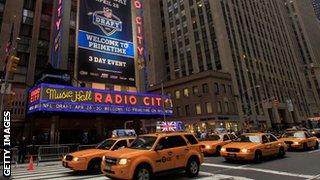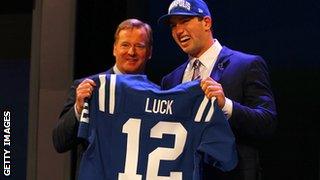NFL Draft 2013: Your essential comprehensive guide
- Published

No points are scored, no championships are won, no trophies are handed out and its results may not be known for years.
We're talking about the NFL Draft, which in recent years has become one of the most eagerly awaited and biggest sporting events in the US sporting calendar.
From Thursday night (early hours of Friday morning in the UK), millions of American football fans will tune into countless hours of analysis as each of the league's 32 teams tries to take the cream of the college crop.
The Draft, held in the glamorous surroundings of Radio City Music Hall in New York, is arguably one of the main reasons why the NFL is so successful - it is exciting and helps to level the playing field between the teams.
History of the NFL Draft |
|---|
The idea was conceived in a meeting of the league's nine owners in May 1935. One of them, De Benneville 'Bert' Bell of the Philadelphia Eagles, proposed a system where teams would pick, in reverse order of where they had finished the previous season, the best players graduating from university.
Bell had become frustrated at the dominance of the four richest teams, the Chicago Bears, the Green Bay Packers, the New York Giants and the Washington Redskins.

The glamorous surroundings of Radio City Music Hall in New York City hosts the NFL Draft
"I made up my mind that this league would never survive unless we had some system whereby each team had an even chance to bid for talent against each other,'' Bell told the Associated Press. "I've always had a theory that pro football is like a chain. The league is no stronger than its weakest link.
"Every year, the rich get richer and the poor get poorer. Four teams control the championships. Because they are successful, they keep attracting the best college players in the open market, which makes them more successful."
Bell's vision became reality a year later with the first NFL draft being held on 8 February, 1936 in Philadelphia.
"Franchise owners crowded into Bert Bell's hotel room, shucked their jackets, and cleared sitting room on beds and bureaus," wrote Robert Lipsyte in the New York Times. "Bottles circulated, solemn oaths of league solidarity were taken, and the college stars were distributed."
That draft succeeded in created a level playing field, attracting bigger audiences which in turn brought higher salaries for the players.
Fully 78 years later, the same system is in place.
How the 2013 NFL Draft works |
|---|
The Draft has seven rounds, with 32 picks in each round to match the NFL's 32 teams.
But because of previous trades of players, some teams have more selections than others. For example, earlier this week the New York Jets traded star cornerback Darrelle Revis to the Tampa Bay Buccaneers in exchange for the Bucs' first-round pick (number 13 overall) and a fourth-round pick in the 2014 Draft.
Picks are like casino chips - they're commodities and teams use them in a myriad of deals in order to maximise their chances of landing their chosen targets.
In the 2013 Draft, the San Francisco 49ers have the most picks with 13. The Carolina Panthers, Chicago and the New England Patriots each only have five.
The 49ers, as Super Bowl runners-up, have the penultimate pick in each round, but possess the currency to trade up, especially high into the first round to select one of the elite players on offer.
How many players are eligible for the Draft? |
|---|
To stand even a remote chance of being drafted, you have to be a seriously good college player.
There are 123 major universities and colleges which play the sport, not to mention the thousands of smaller schools whose players, so long as they are three years removed from high school, are eligible to be drafted.
Of approximately 1.1m high school football players, only around 68,000 are good enough to play college football.
Of that number, only 255 are drafted by NFL teams - approximately 1.7%.
With so much talent available, it is perhaps no surprise that teams invest millions of dollars researching would-be players to the nth degree.
Players' backgrounds, both physical and mental, are analysed in order to hopefully weed out the bad apples or the potential busts.
Draftees are the lifeblood of a team and bad drafts can ruin a team's progress and cost a head coach or his general manager their job.
How are Drafts evaluated? |
|---|
Coaches, general managers and scouts are judged as much on collegiate talent acquisition as they are on wins and losses on the field.
There's a direct correlation between draft success and winning - it's no coincidence that the Baltimore Ravens and San Francisco - who played out the Super Bowl in February - have two of the best general managers in the NFL in Ozzie Newsome and Trent Baalke.
On the flipside of that, the Miami Dolphins have been to the play-offs just three times since 2000. In that time they've drafted 97 players, including 10 in the first round. Of those 97, only 22 are still with the Dolphins and only three of their first-round picks remain.
It is no wonder the Dolphins have had seven head coaches and four general managers in that period.
On The Clock |
|---|

Andrew Luck (right) was the first pick in last year's NFL Draft - he went to the Indianapolis Colts
Each team has 10 minutes to make their pick in Round One (seven minutes per selection in the second round and five minutes in each of the subsequent rounds).
Sometimes teams will make their selection immediately, but often they will be fielding calls from other teams wanting to trade up or they will be calling other teams trying to trade down.
Round One is where most of the excitement happens - the trades, the rumours and the subterfuge as each team try to keep the player they want to draft a secret from other teams who may also have an interest.
And there are only so many elite players in each Draft.
How do trades work? |
|---|
When teams consider trading picks to move up or down the board, they use a value chart, originally created by the former Dallas Cowboys head coach Jimmy Johnson and honed over the past few years to resemble the ever-changing nature of the game.
Each pick has a value attached to it. The first overall pick and therefore the opportunity to select the best eligible player is worth 3,000 points. The number two pick is worth 2,600. The number six pick is worth 1,600 and the value of the 38th pick is worth 520 points.
If you have the sixth overall selection but want to move up to the first spot, you need to strike a deal of picks that gets close enough to compensating the team trading down with that 3,000 points.
In the 2011 Draft, the Atlanta Falcons moved up from the 27th overall spot to the sixth position owned by the Cleveland Browns so they could draft University of Alabama wide receiver Julio Jones.
The Falcons sent the Browns five draft picks in exchange for that sixth pick; their first rounder at 27, their second round pick at 59 and their fourth round pick at 124. They also sent them their first-round pick and their fourth-round pick in the 2012 Draft.
It was a huge price to pay but the Falcons got their man and the Browns got five picks in return.
The value of a good Draft |
|---|
In 1986 the 49ers had 13 picks. Of them, head coach Bill Walsh accrued eight players who would become the cornerstone of their dynasty for more than a decade and collectively earn 22 Super Bowl winners' rings during their NFL careers.
It is often referred to as the greatest single Draft of all time as Walsh turned the greatest non-sporting, sporting event in the world from a lottery into something totally elementary.
That is what every NFL team will be striving for come 20:00 Eastern time in the United States (01:00 BST Friday).
You can listen to BBC Radio 5 live's NFL Draft Preview programme by clicking here, external. Live coverage of the first round will be on BBC Radio 5 live Sports Extra from 00:30 BST on Friday
- Published22 April 2013
- Published31 March 2013
- Published4 April 2013